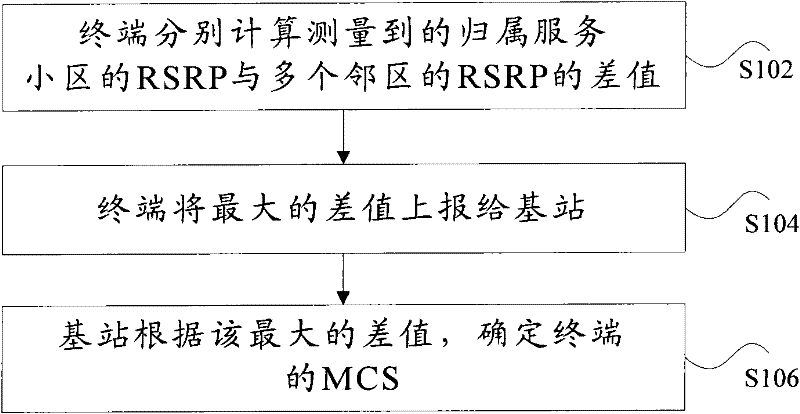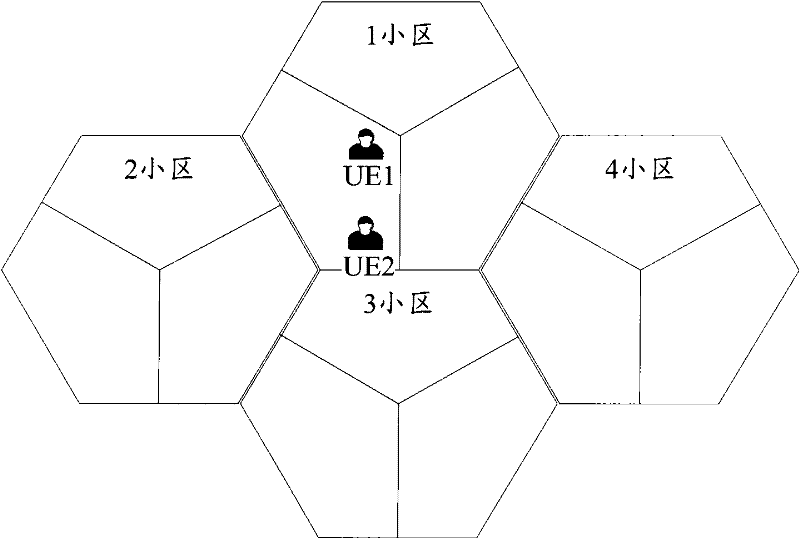Link Adaptation Method, Base Station and Terminal in LTE System
一种链路自适应、终端的技术,应用在通信领域,能够解决增加系统开销、流程复杂等问题,达到频谱效率高、简化流程的效果
- Summary
- Abstract
- Description
- Claims
- Application Information
AI Technical Summary
Problems solved by technology
Method used
Image
Examples
Embodiment 1
[0046] Such as figure 2 As shown, the specific processing flow of the link adaptation method in the LTE system according to the embodiment of the present invention includes the following steps:
[0047] Step S202, the base station configures the number of neighboring cells that the UE needs to measure as n, and the UE acquires the number n;
[0048] Step S204, the UE measures the RSRP value of the serving cell (denoted as RSRP0) and the RSRP values of the n neighboring cells (respectively denoted as RSRP1, RSRP2, ... RSRPn), and the UE calculates RSRP0 and RSRP1, RSRP2, . .. The difference of RSRPn, respectively recorded as ΔRSRP1, ΔRSRP2, ... ΔRSRPn;
[0049] In step S206, the UE selects a maximum value among the multiple differences calculated in step S204, which is recorded as ΔRSRPmax, and reports ΔRSRPmax to the base station (it can be included in the measurement report for reporting);
[0050] In step S208 , the MCS value and the corresponding code rate correspondin...
Embodiment 2
[0053] Such as image 3 As shown, there are two UEs in one cell, which are UE1 and UE2 respectively. According to the processing method of the method of the embodiment of the present invention, they need to measure the RSRP value of the serving cell, that is, cell 1, and the RSRP values of the other three neighboring cells (cell 2, cell 3, and cell 4).
[0054] Since the location of UE1 is closer to the center of the cell, the maximum difference between the RSRPs of its serving cell and neighboring cells must be larger than that of UE2. In this way, according to the corresponding simulation curve or the corresponding relationship table, the MCS and code rate that the base station can allocate to UE1 must be greater than that of UE2. It can ensure that UE1 with better channel quality is assigned a higher-order MCS to increase the data transmission rate, while UE2 with relatively poor channel quality is assigned a lower-order MCS and a lower code rate, which can improve the r...
Embodiment 3
[0056] Such as image 3 As shown, during the moving process of the UE, since the UE periodically measures the RSRP of the current cell (that is, the serving cell) and the neighboring cell, the base station can dynamically obtain the maximum difference reflecting the position of the UE, and can flexibly Perform MCS configuration and power control.
[0057] Figure 4 It is a schematic diagram of a base station and a terminal according to an embodiment of the present invention. The base station 10 includes: a receiving module 102, configured to receive the maximum difference reported by the terminal 20, wherein the maximum difference is the home service measured by the terminal respectively calculated The maximum value among the multiple differences obtained by the difference between the RSRP of the cell and the RSRPs of multiple neighboring cells; the MCS determining module 104 is configured to determine the MCS of the terminal 20 according to the maximum difference.
[0058] ...
PUM
 Login to View More
Login to View More Abstract
Description
Claims
Application Information
 Login to View More
Login to View More - R&D
- Intellectual Property
- Life Sciences
- Materials
- Tech Scout
- Unparalleled Data Quality
- Higher Quality Content
- 60% Fewer Hallucinations
Browse by: Latest US Patents, China's latest patents, Technical Efficacy Thesaurus, Application Domain, Technology Topic, Popular Technical Reports.
© 2025 PatSnap. All rights reserved.Legal|Privacy policy|Modern Slavery Act Transparency Statement|Sitemap|About US| Contact US: help@patsnap.com



